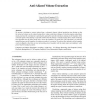Free Online Productivity Tools
i2Speak
i2Symbol
i2OCR
iTex2Img
iWeb2Print
iWeb2Shot
i2Type
iPdf2Split
iPdf2Merge
i2Bopomofo
i2Arabic
i2Style
i2Image
i2PDF
iLatex2Rtf
Sci2ools
VISSYM
2003
2003
Anti-Aliased Volume Extraction
We present a technique to extract regions from a volumetric dataset without introducing any aliasing so that the extracted volume can be explored using direct volume rendering techniques. Extracting regions using binary masks generated by contemporary segmentation approaches typically introduces aliasing at the boundary of the extracted regions. This aliasing is especially visible when the dataset is visualized using direct volume rendering. Our algorithm uses the binary mask only to locate the boundary. The main idea of the algorithm is to retain the natural fuzziness at the boundary of a region even after it is extracted. To achieve that, intensities of the boundary voxels are flipped so that they are now representing a fuzzy boundary with the empty region surrounding it, while preserving the boundary position. Categories and Subject Descriptors (according to ACM CCS): I.4.3 [Image Processing And Computer Vision]: Grayscale Manipulation I.3.7 [Computer Graphics]: Three-Dimensional ...
| Added | 01 Nov 2010 |
| Updated | 01 Nov 2010 |
| Type | Conference |
| Year | 2003 |
| Where | VISSYM |
| Authors | Sarang Lakare, Arie E. Kaufman |
Comments (0)

